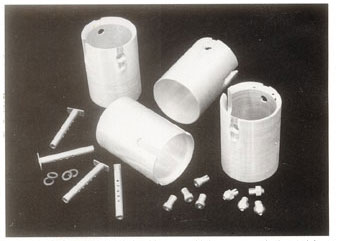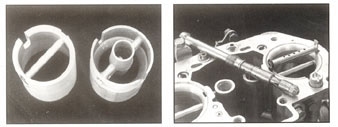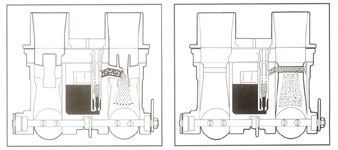Hot VW's - January 2000 - Cooking with the IDF
Updating a classic design for better air flow and more horsepower.

BY
JEFF HOLIFIELD
Unquestionably,
the most popular line of performance carburetors used on VW's
venerable boxer engine come from "Weber Carburetore"
is Bologna, Italy. Over the last three decades, various Weber
designs have been installed on air-cooled engines. By far and
away, the dual-throat IDF series has proven to be th most popular
with professional VW performance tuners, as well as home hobbyists.
Used in single
and dual carburetor applications, the Italian-designed IDF is
a true work of art, and is currently available in 40mm, 44mm,
and 48mm bore sizes. In addition to the three basic sizes, the
IDF offers an incredible amount of flexibility, thanks to changeable
main jets, idle jets, air correction jets, accelerator pump
jets, emulsion tubes, and venturis. The seemingly endless combination
of parts allow the Weber IDF carburetor to be tuned to just
about any performance engine combination.
 |

ABOVE, CB Performance's IDF Update Kit comes with four new,
oversized venturi, four horizontal discharge tubes, and sealing
O-rings. As airflow is significantly increased, a larger main
jet is required, as well as a new air correction jet. Both are
supplied.
|
| 
ABOVE LEFT, CB Performance venturi vs. the restrictive Weber
auxiliary venturi and 28mm main venturi from a standard 40 IDF.
ABOVE RIGHT, the main jet stack holds the main jet and air correction
jet, both of which need to be changed. Note second horizontal
discharge tube (with O-Ring) shown upside-down for comparison.

ABOVE, the horizontal discharge tube carburetor is nothing new.
A means to simple fuel distribution, it dates back to pre-WWII.
The left diagram shows the standard Weber IDF use of an auxiliary
venturi, and main venturi to pull fuel into the combustion chamber.
The CB kit replaces these items with a single, larger diameter
venturi and spray bar.
|
For all
its adjustments, there is one limitation of the IDF carburetor which
is not easy to overcome. Once dual carburetors are installed and tuned
to a particular engine combination, there has not been a cost-effective
means to increase horsepower from further modification. Traditionally,
if you wanted more power from carburetion alone, you would have to step
up to the next size larger IDF (i.e. from 40mm to 44mm). In today's
market, that represents a major investment (somewhere in the neighborhood
of $600).
Five Years
ago, CB Performance of Farmersville, California, created an "Update
Kit" that proved to be a solution to this shortcoming. A simple
bolt-in modification, the update increased the air flow through the
carb, and thus the horse-power potential. Problem being, the modification
only worked on dual throat Dellorto DRLA carburetors.
Though
similiar in design, CB Performance just couldn't get the Dellorto update
kit to work on the Weber IDF carburetor as the Weber body casting was
just too different. The project was shelved, that is, until a few months
ago when on of CB's designers came up with an all new design for the
IDF carb. Within weeks, a protostype IDF Update Kit was installed, and
it worked beautifully.
Now in
production, the IDF Update Kit replaces the Weber auxiliary venturi
and main venturi with CB Performance's new, single venturi and a horizontal
discharge tube. The new venturi has a significantly larger I.D. than
the stock unit, and allows a higher flow of air through the carburetor
for increased performance.

The
installation of CB's IDF update kit is straight forward, and
easily accomplished with the carburetors still mounted on the
engine. Nevertheless, if it was our engine, we would remove
the carbs just to make sure nothing get into the combustion
chamber by accident. ABOVE and CENTER, remove the jet stacks,
linkage, and carburetor top. Note the float is attached to the
top ... do not set the top down on the float, turn it upside
down. ABOVE RIGHT, remove the accelerator pump jets, and the
lower copper gasket.
|

ABOVE,
removing the auxillary venturi (a.k.a. boost venturi) is often
easier said than done, particularly on older carburetors. If
fickle, turn the carb on its side, open the butterfly, and with
the help of an appropriately sized wood dowel, lightly tap out
the booster. ABOVE CENTER and RIGHT, loosen the lock nut, and
remove the set screw holding the main venturi in place. Remove
the venturi.
|

ABOVE,
working with the parts supplied in the IDF Update Kit, select
one horizontal discharge tube, and one CB Performance venturi.
With the perforations facing downward, slide the discharge tube
into the venturi. ABOVE CENTER, take a sealing O-ring, and push
over the end of the tube. ABOVE RIGHT, slide the venturi assembly
into the IDF body, making sure the O-ring is located toward
the center of the carb. Note the location of the clearance cut
for the pump jet, and the small dimple (arrow) for the set screw.
|

Repeat
the above procedure for the boare of the IDF. Note the horizontal
discharge tube will need to be slipped in from the opposite
side as the first one for the O-ring, clearance-cut, and set
screw dimple to be properly located. ABOVE LEFT, install the
venturi set screw with a screw driver, and tighten with a wrench.
ABOVE CENTER, install the accelerator pump jet with its lower
copper gasket. ABOVE RIGHT, add top (with float and base gasket)
and lightly tighten screws in a criss-cross pattern
|
Reprinted
from the January 2000 edition of DUNE BUGGIES AND HOT VW'S
|







